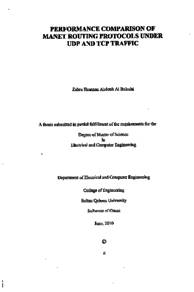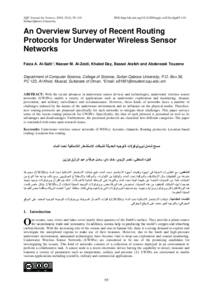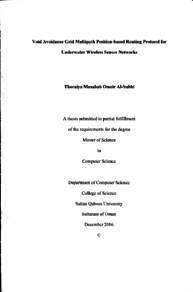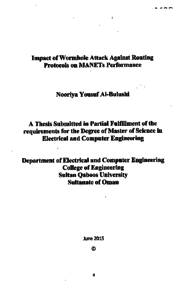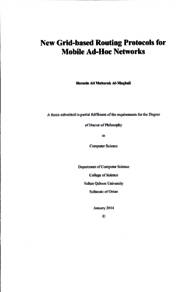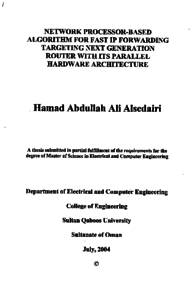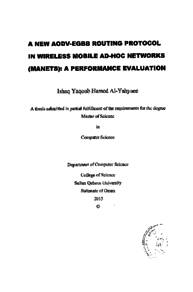وثيقة
Performance comparison of manet routing protocols under UDP and TCP traffic.
الناشر
Sultan Qaboos University
ميلادي
2010
اللغة
الأنجليزية
الموضوع
الملخص الإنجليزي
One of the main attractive features of Mobile Ad-hoc networks (MANETs) is their ability to operate in a standalone fashion without a central administration. As a consequence, they can be used in many useful and important applications including military fields, rescue operations, and for quick file sharing.
This research presents a performance analysis of three well-known MANET routing protocols, notably Ad-hoc On-Demand Distance Vector (AODV), Dynamic Source routing (DSR) and Destination-Sequenced Distance Vector (DSDV), using the widely-used NS-2 software simulation tool. Both AODV and DSR are reactive (on demand) routing protocols whereas DSDV is proactive. Our simulation study assesses the impact of varying node mobility, network load, and network size on the performance of the three routing protocols with respect to the following performance metrics; packet delivery ratio, end-to-end delay and throughput. Simulations are conducted using two transport protocols, namely TCP and UDP. TCP is a reliable protocol and it carries over 80% of the internet traffic today, serving many data applications like file transfer and WWW browsing [38, 40). Hence, its deployment over MANETs is essential. UDP, on the other hand, is an unreliable protocol and it is used in many applications that require minimal delays like video streaming and Voice over IP (VOIP) [57].
Our simulation results reveal that AODV outperforms both DSDV and DSR in terms of packet delays even in most congested network conditions for both TCP and UDP traffic. Moreover, DSR experiences performance degradation despite the fact that it is a reactive protocol like AODV, DSR can operate more efficiently in small sized networks under low traffic conditions. However, for larger networks and increased congestion and continuous node mobility, AODV outperforms both DSR and DSDV in terms of throughput and packet delays. DSDV, on the other hand, can work efficiently in small-sized networks and low node mobility. Our results also show that packet delays for TCP traffic are higher than that for its UDP counterpart. This finding highlights the fact that lot of research still needs to be carried out in order to make MANET protocols more efficient for TCP traffic.
المجموعة
URL المصدر
الملخص العربي
من أهم الملامح الجذابة في شبكات الجوال العشوائية (MANETs) هي قدرتها على العمل دون ادارة مركزية. ونتيجة لذلك, ويمكن استخدامها في العديد من المجالات المفيدة والهامة مثل المجال العسكري و عمليات الإنقاذ وسرعة تبادل الملفات. هذا البحث يقدم عرضا جيدا لتحليل الأداء الثلاثة من البروتوكولات تلمعروفة بشبكات الجوال العشوائية, وبصفة خاصة ومتخصصة الطلب ناقلات المسافات ,(AODV و ديناميكية المصدر تحديد المسارات (DSR) وناقل الوجهة متسلسلة المسافة (DSDV) باستخدام برنامج المحاكاة 2-NS. يعتبر كلا من DSR و AODV من بروتوكولات رد الفعل بينما DSDV من بروتوكولات الاستباقية هذه الدراسة يقيم اثر اختلاف التنقل و تحميل الشبكة و حجم الشبكة باداء البروتوكولات الثلاثة في ما يتعلق بمقاييس الأداء التالية : نسبة توصيل حزمة التأخير والإنتاجية وتجري عمليات المحاكاة باستخدام البروتوكولات النقل التالية TCP و UDP , بروتوكول TCP واقعي و يحمل اكثر من 80% من عدد كبير من البيانات على شبكة الإنترنت لخدمة الحركة اليوم و يقضي العديد من تطبيقات البيانات مثل نقل الملفات تطبيقات تصفح الموقع www [40 ,38]. وبالتالي فإن استخدامه في MANETs أمر ضروري. UDP من جهة أخرى بروتوكول غير واقعي يستخدم في العديد من التطبيقات التي تتطلب حدا أدني للتأخير مثل الاتصالات الصوتية عبر الإنترنت و تيار الفيديو [57]. وتكشف نتائج هذه الدراسة أن AODV تتفوق على DSR و DSDV من حيث تأخير الحزم حتى ان كانت الشبكة مزدحمة سواء باستخدام TCP او UDP . ومن جهة أخرى, DSR يواجه تدهور الأداء رغم انها بروتوكول رد الفعل مثل DSR . AODV يمكن أن تعمل بصورة أكثر كفاءة في شبكات صغيرة الحجم قليلة تحت ظروفه انخفاض حركة المرور المرور. لكن AODV تعمل بصورة أكثر كفاءة في الشبكات الكبيرة وزيادة الازدحام والتنقل المستمر مقارنة بDSR و DSDV DSDV من جهة أخرى, يمكنها العمل بكفاءة في مشاريع صغيرة الحجم شبكات قلة الحركة. النتائج تظهر ايضا ان تأخير حزمة باستخدام TCP أعلى منه باستخدام UDP, نتائج هذه الدراسة يسلط الضوء ايضا على أنه لا يزالهناك حاجة للكثير من الأبحاث من أجل جعل MANETs اكثر كفائة باستخدام TCP .
قالب العنصر
الرسائل والأطروحات الجامعية

